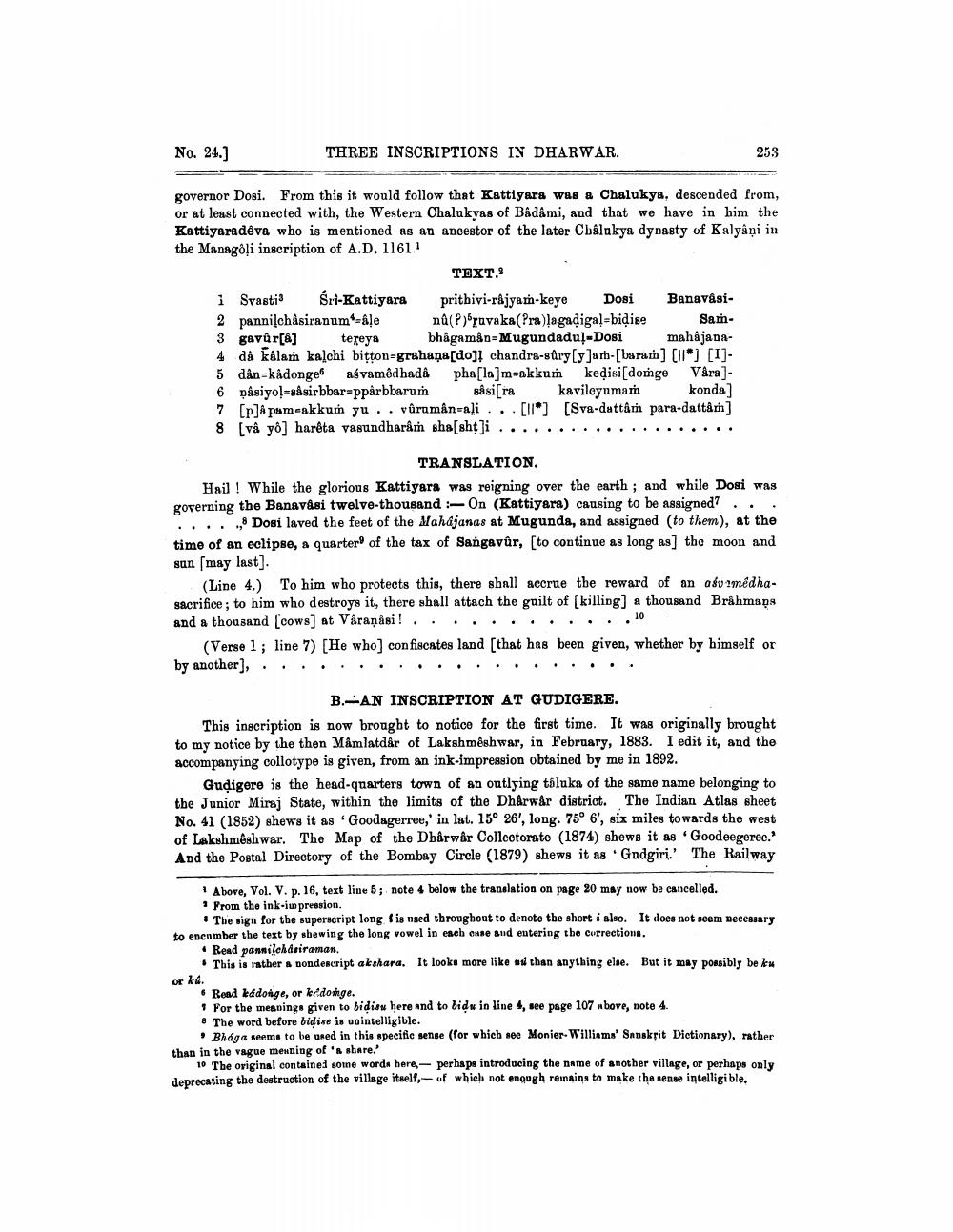________________
No. 24.]
governor Dosi. From this it would follow that Kattiyara was a Chalukya, descended from, or at least connected with, the Western Chalukyas of Bâdâmi, and that we have in him the Kattiyaradeva who is mentioned as an ancestor of the later Châlnkya dynasty of Kalyani in the Managoli inscription of A.D. 1161.1
THREE INSCRIPTIONS IN DHARWAR.
Sri-Kattiyara
TEXT.3
1 Svasti3
prithivi-râjyam-keye nû(?)ruvaka (Pra)lagadigal-biḍise
2 pannilchâsiranum*=âle
Dosi BanavâsiSammahâjana
3 gavûr[a] tereya
bhagamân-Mugundadul-Dosi
4 dâ kâlam kalchi bitton-grahana [do]] chandra-sûry [y]am-[baram] [*] [I]5 dân=k&donge aśvamêdhadâ pha[la]m-akkum keḍisi[domge Vâra]6 pasiyol-såsirbbar=ppårbbarum sâsi[ra konda]
kavileyuma
7 [p] pam-akkum yu.. vûrumân-ali... [1] [Sva-dattâm para-dattâm] 8 [va yô] harêta vasundharâm sha[sht]i
253
TRANSLATION.
Hail! While the glorious Kattiyara was reigning over the earth; and while Dosi was governing the Banavasi twelve-thousand- -On (Kattiyara) causing to be assigned? . .
...., Dosi laved the feet of the Mahajanas at Mugunda, and assigned (to them), at the time of an eclipse, a quarter of the tax of Sangavûr, [to continue as long as] the moon and sun [may last].
(Line 4.) To him who protects this, there shall accrue the reward of an aśvmedhasacrifice; to him who destroys it, there shall attach the guilt of [killing] a thousand Brahmans and a thousand [cows] at Varanasi! .. .10
(Verse 1; line 7) [He who] confiscates land [that has been given, whether by himself or by another],..
B. AN INSCRIPTION AT GUDIGERE.
This inscription is now brought to notice for the first time. It was originally brought to my notice by the then Mâmlatdar of Lakshmêshwar, in February, 1883. I edit it, and the accompanying collotype is given, from an ink-impression obtained by me in 1892.
Gudigere is the head-quarters town of an outlying tâluka of the same name belonging to the Junior Miraj State, within the limits of the Dhârwâr district. The Indian Atlas sheet No. 41 (1852) shews it as 'Goodagerree,' in lat. 15° 26', long. 75° 6', six miles towards the west of Lakshmêshwar. The Map of the Dhârwâr Collectorate (1874) shews it as 'Goodeegeree." And the Postal Directory of the Bombay Circle (1879) shews it as Gndgiri.' The Railway
.
Above, Vol. V. p. 16, text line 5; note 4 below the translation on page 20 may now be cancelled.
From the ink-impression.
The sign for the superscript long fis nsed throughout to denote the short i also. It does not seem necessary
to encumber the text by shewing the long vowel in each case and entering the corrections.
Read pannilehdeiraman.
This is rather a nondescript akshara. It looks more like nd than anything else. But it may possibly be ku
or kú.
Read kádonge, or kedomge.
For the meanings given to bidisu here and to bidu in line 4, see page 107 above, note 4.
The word before bidise is unintelligible.
Bhaga seems to be used in this specific sense (for which see Monier-Williams' Sanskrit Dictionary), rather than in the vague meaning of 'a share.
10 The original contained some words here, deprecating the destruction of the village itself,
perhaps introducing the name of another village, or perhaps only of which not enough remains to make the sense intelligible.




